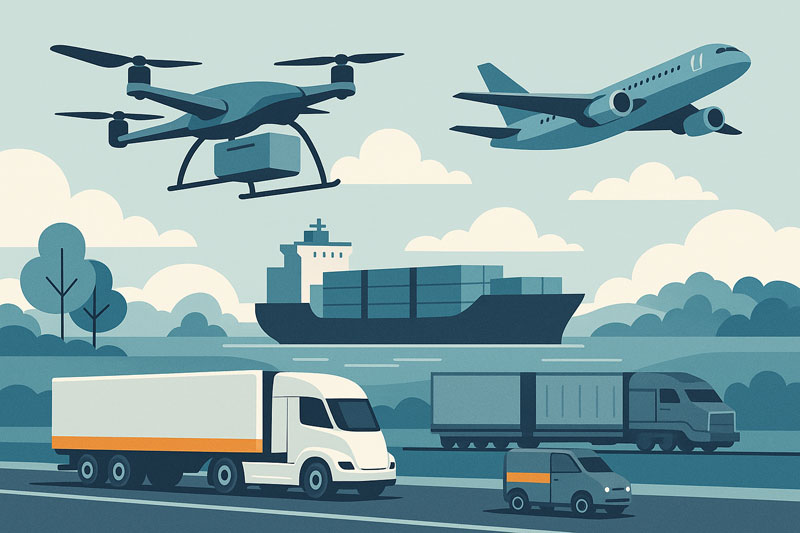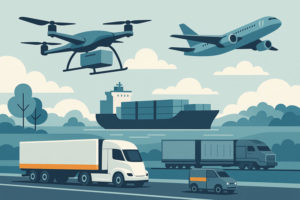The freight sector is undergoing major transformation, influenced by technological advancements, growing environmental concerns, and shifting economic dynamics. In 2025, these changes bring both opportunities and challenges for industry players.
Let’s explore the key trends shaping freight in 2025, highlighting major innovations, the impact of artificial intelligence (AI), employment prospects, business closures in air, road, and sea freight, as well as the emergence of drone freight.
Land Freight and Technological Innovations
Autonomous and Electric Vehicles
The adoption of autonomous vehicles is advancing significantly. In 2025, major progress has been made, including the expansion of Operational Design Domains (ODD) and the first driverless journeys on major highways, demonstrating the potential of autonomous driving. At the same time, electric trucks are gaining popularity, with manufacturers like Renault Trucks producing 44-ton electric trucks since 2023. These vehicles, with a range of 300 kilometers, symbolize the shift toward more sustainable logistics.
Digitalization and Artificial Intelligence
Digitalization is transforming freight management, with the integration of technologies such as artificial intelligence (AI) to optimize operations. AI is being used for route optimization, thereby improving operational efficiency and reducing costs. In addition, emerging technologies are driving the move toward greener logistics, including logistics hubs powered by renewable energy.
Digital Automatic Coupling
The European Digital Automatic Coupling (DAC) project aims to standardize freight train coupling, thereby enhancing efficiency and safety in rail transport. In 2024, a key milestone was reached with the selection of the Scharfenberg coupler head as the DAC standard, ensuring interoperability and optimal operational performance.
Impact of Artificial Intelligence on Freight
Supply Chain Optimization
Artificial intelligence plays a crucial role in optimizing supply chains. By analyzing massive datasets, AI can anticipate future needs and adjust inventory accordingly, thereby reducing costs and improving operational efficiency.
Predictive Maintenance and Safety
In the road transport sector, AI enables predictive maintenance of vehicles, reducing breakdowns and increasing fleet availability. It also contributes to road safety by analyzing driving behaviors and providing real-time feedback to drivers.
Employment Outlook in the Freight Sector
Changing Skill Requirements
The increasing integration of AI and automation in the freight sector is reshaping the skills required. Employees now need to master advanced technological tools and understand automated systems. This shift creates demand for specialized training and continuous skills adaptation.
Impact on Employment
While automation may reduce the need for labor in repetitive tasks, it also generates new job opportunities in the management, maintenance, and analysis of automated systems. The freight sector therefore continues to offer employment prospects, but with evolving job profiles.
Business Closures in the Freight Sector
Rail Freight
In 2024, the European Commission required the break-up of Fret SNCF due to €5.3 billion in illegal state aid received between 2007 and 2019. This decision led to the creation of two new entities, Hexafret and Technis, and a 10% workforce reduction. Trade unions expressed concern over the impact of this restructuring on employment and service quality.
Maritime Freight
French ports suffered a significant blow when shipping companies Maersk and Hapag-Lloyd announced they would stop serving them directly as of February 2025. This decision weakens the competitiveness of Le Havre and Marseille-Fos ports, in favor of ports where these companies own terminals, enabling faster and more reliable operations.
Air Freight
In 2024, the air freight sector saw the closure of several airlines. According to CH-Aviation data, 27 airlines ceased operations that year due to various reasons such as operational difficulties, financial problems, or mergers and acquisitions.
(Source: Air Journal)
Some of the affected airlines include:
- Celeste: This Breton airline never launched commercial flights due to financial issues and the lack of an operating license. Placed under judicial reorganization in May 2024, it was liquidated in June of the same year.
- Air Malta: The national carrier of Malta ceased operations in 2024, although the exact reasons were not disclosed in available sources.
- Jet Airways: After an attempted revival, this Indian airline ceased operations again in 2024 due to ongoing financial troubles.
- LIAT: Based in the Caribbean, this airline also shut down in 2024, likely due to financial challenges.
It is important to note that despite these closures, the air freight sector remains dynamic, with many specialized operators continuing to innovate and meet market demands.
These closures reflect the ongoing challenges in the air freight industry, despite a general recovery in traffic. They underscore the need for airlines to adapt to market changes and strengthen their resilience to economic shocks.
Drone Freight : A Reality in 2025
Drone Development
Drone freight has become a reality in 2025, with companies like Dronamics developing dedicated drone freight networks. Their flagship drone, the Black Swan, can carry 350 kg over distances of up to 2,500 km, offering an efficient alternative to traditional delivery methods.
Regulation and Challenges
Despite technological progress, regulatory frameworks still limit the use of drones for cargo transport, particularly in urban areas. Initiatives such as Transport Canada’s Drone Strategy for 2025 aim to integrate these aircraft safely into airspace, but challenges remain in terms of safety and public acceptance.
In Conclusion
In 2025, the freight sector stands at a strategic crossroads, shaped by major technological, economic, and environmental challenges—but also rich in opportunities for innovation and growth. The increasing integration of artificial intelligence and automation is profoundly transforming traditional operations, creating new employment niches while driving the closure or restructuring of less adaptable companies.
The shutdown of major players such as Fret SNCF, and the difficulties faced by French ports following decisions by Maersk and Hapag-Lloyd, highlight the critical need to anticipate market changes. At the same time, the promising rise of drone freight, led by innovative companies like Dronamics, shows that the sector remains dynamic and capable of reinvention through disruptive technologies.
The future success of the freight industry will depend on the ability of companies to seize opportunities brought by digitalization, intelligent automation, and the emergence of sustainable solutions, while adapting their strategies to new economic and regulatory realities.









